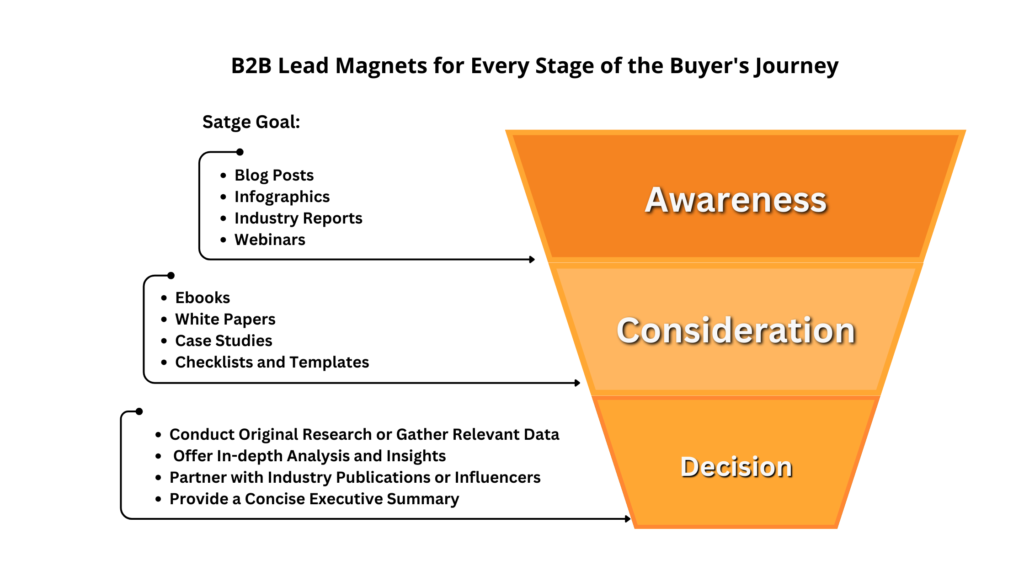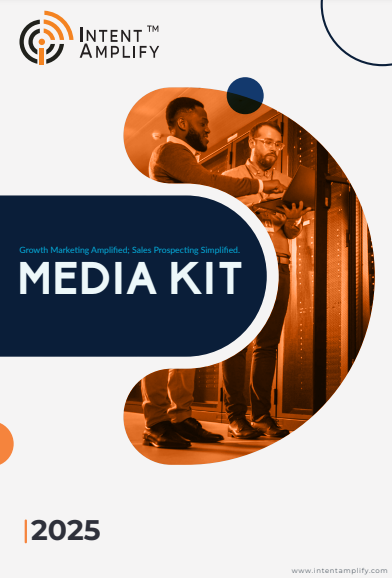
B2B Lead Magnets for Each Stage of Buyers’ Journey
- Last updated on: March 4, 2024
Before we talk about B2B lead magnet ideas at each stage of the buyer journey, we should talk about the stages of the buyer journey. Tailoring your lead magnets to each stage is crucial for maximizing their effectiveness and attracting qualified leads.
A prospective customer has to travel a considerable distance from becoming aware of the offering and converting into a buyer. This travel is better known as the buyer’s journey and is an integral part of the sales funnel. But why is it important? Before that, let’s quickly skim through the various stages of the buyer journey to take it out of the way.
The 5 Stages of a Buyer’s Journey
1. Awareness:
A prospect makes contact with your brand through an ad, a social media post, perhaps a friend of theirs told them, or any other way of marketing.
2. Consideration:
Consumers start considering your product as a potential answer to their needs.
3. Purchase:
Realising that your offering fits their problem, they choose your product.
4. Retention:
The customer finds your product/service useful and decides to stick around your brand exhibiting a certain level of brand loyalty.
5. Advocacy:
The customer reviews the product/service – either positive or negative.
By understanding the different stages of the buyer’s journey and tailoring your lead magnets accordingly, you can ensure you’re providing the most relevant and valuable content at the right time, ultimately attracting and converting more qualified leads into paying customers. Now let’s understand what would be the lead magnets required at every stage of the buyer’s journey.
B2B Lead Magnets for Every Stage of the Buyer’s Journey
Making a lead magnet or content offer that aligns with a specific stage of the buyer journey helps you be much more strategic. Visitors will find it intuitively. The next step will seem natural. Nothing will feel forced. To create this type of asset, you want to start from the beginning of your customer strategy and ensure you understand what the customer wants and when they want it.
The first thing even before creating a lead magnet is to define your buyer persona. The challenge they are facing is the primary problem you need to solve. If you have not yet defined your buyer persona, that’s what you do here. For buyer personas, check out this blog.

Next, let us see what content can be used for the 3 key stages.
1. Awareness Stage
Prospects at stage zero of the funnel are new to the journey and they should be presented with educative and informative content. To illuminate their path, offer insightful and educational e-books. Talk about topics addressing industry challenges, emerging trends, and potential solutions. The idea is to present yourself as a “knowledgeable guide” in their exploration. Here are the B2B lead magnets that work for this stage.
Blog Posts:
The focus here is to provide educational and informational content that talks about the problems the customers are facing and provides probable solutions. Provide actionable insights and tips to help them understand the problem better, explore potential solutions, and recognize the value your industry can offer. Maintain a consistent posting schedule to establish yourself as a reliable source of information and build brand recognition. Optimize your blog posts for search engines (SEO) to increase organic reach and attract potential customers actively searching for related topics.
- Infographics: Visually represent complex data or trends related to the industry or the specific problem your target audience faces. Use clear and concise visuals, charts, and icons to communicate information effectively and make the content easily digestible. Ensure your infographics are visually appealing and shareable across social media platforms and other online communities. Include a call to action (CTA) that directs viewers to learn more about your company or download a related lead magnet.
- Industry Reports: Conduct original research or gather data related to industry trends, challenges, and potential solutions. Offer in-depth analysis and insights that demonstrate your expertise and understanding of the industry landscape. Partner with industry publications or influencers to distribute your report and reach a wider audience. Provide a concise executive summary to give readers a quick overview of the key findings and benefits of accessing the full report.
- Webinars: Host educational sessions on topics relevant to the problem and potential solutions, addressing common questions and concerns. Invite industry experts or thought leaders to participate in your webinars and offer diverse perspectives. Promote your webinars through various channels such as social media, email marketing, and industry publications. Offer recordings of past webinars on-demand so prospects who can’t attend live sessions can still access the valuable content.
2. Consideration Stage
As prospects move into the consideration stage, they seek deeper insights. Organize webinars featuring industry experts to delve into complex subjects. Additionally, offer detailed whitepapers that provide in-depth analyses, helping prospects weigh their options. This stage is about fostering a deeper connection by showcasing your expertise. Here are the B2B lead magnets that work for this stage.
- Ebooks: Offer in-depth, downloadable guides that delve deeper into specific topics related to the problem and potential solutions. Provide a structured and comprehensive approach to understanding the challenges, evaluating options, and implementing solutions. Include actionable steps, case studies, and expert insights to showcase your knowledge and establish trust with potential customers.
- White Papers: Offer research-backed insights and data that address specific pain points and showcase your expertise in the industry. Provide data visualizations, charts, and graphs to present complex information in a clear and compelling way. Focus on providing objective and unbiased analysis while subtly highlighting the unique value proposition of your solution.
- Case Studies: Share real-world stories of how you helped similar businesses overcome challenges relevant to your target audience. Quantify the results achieved by the client to demonstrate the tangible benefits of your offering. Highlight the specific challenges addressed and solutions implemented to showcase your problem-solving capabilities and industry expertise. Include testimonials and quotes from satisfied clients to add credibility and emotional connection to the case study.
- Checklists and Templates: Offer practical and actionable resources that guide prospects through the decision-making process. Develop checklists that outline key factors to consider when evaluating different vendors and solutions. Create templates that help prospects compare features, benefits, and pricing of various options, including yours. Ensure these resources are visually appealing and easy to use, making them valuable tools for informed decision-making.
3. Decision Stage
The decision stage is where prospects are ready to drop anchor and make a commitment. Offer them practical experiences through free trials of your product or service. Additionally, provide personalized consultations to address specific needs. This hands-on approach allows prospects to gauge the value you bring and instills confidence in their decision-making process. Here are the B2B lead magnets that work for this stage.
Conduct Original Research or Gather Relevant Data:
Identify key industry trends, challenges, and potential solutions relevant to your target audience. Conduct original research which involves surveys, interviews with industry experts, or data analysis through publicly available sources. If original research isn’t feasible, compile data from reliable sources like industry reports, government publications, or reputable research institutions.
- Offer In-depth Analysis and Insights: Go beyond simply presenting data. Analyze the information, identify trends and patterns, and provide unique insights not readily available elsewhere. Connect data to real-world situations by using case studies, industry examples, and expert opinions to make the report relatable and impactful. Offer actionable recommendations based on your findings, and provide practical guidance for businesses navigating the industry landscape.
- Partner with Industry Publications or Influencers: Collaborate with industry publications or respected influencers to distribute your report. This expands your reach and leverages your existing audience. Offer co-branding opportunities or provide exclusive early access to their subscribers in exchange for promoting your report. Leverage the influencer’s expertise to contribute to a guest section or provide an interview for the report, further enhancing its credibility.
- Provide a Concise Executive Summary: Offer a clear and concise overview of the report’s key findings and benefits in an easily digestible format. Include key statistics, charts, or visuals to highlight the main takeaways without overwhelming the reader. Clearly outline the value proposition of accessing the full report. Briefly mention additional data, in-depth analysis, or exclusive insights available only in the complete version.
Conclusion
By deploying a diverse array of B2B lead magnets, each strategically crafted for specific stages, you not only capture attention but guide your prospects toward becoming valued clients. Embrace the diversity of lead magnets, navigate the intricate landscape of the buyer’s journey, and watch as your B2B relationships flourish.




